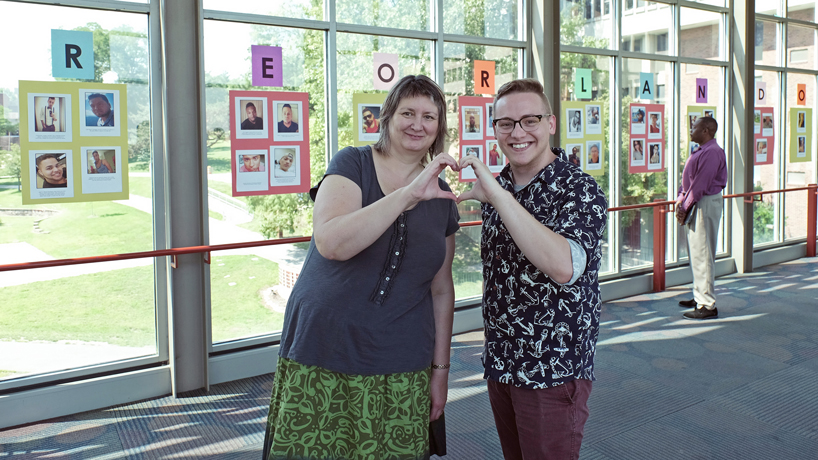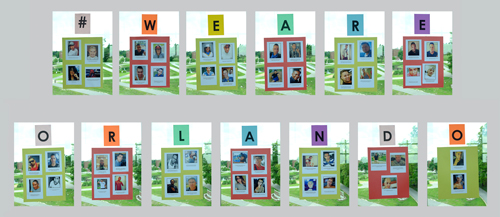
Lynn Staley and Cody Schara stand in front of a memorial to shooting victims in Orlando on display on the bridge to the Millennium Student Center. (Photos by August Jennewein)
An attack earlier this summer at the Pulse nightclub in Orlando, Florida, shook people across the country, including at the University of Missouri–St. Louis.
Members of the UMSL faculty and staff from the College of Arts and Sciences, Counseling Services, Gender Studies and the Millennium Student Center have collaborated on a project to memorialize the 49 people who died and 53 others injured in the June 12 shooting while showing support for the LGBTQ community on campus.
“The LGBTQ family faces so much violence and discrimination already,” said Lynn Staley, an associate teaching professor, who worked on the project. “This is just an extreme example of something that happens very regularly to that community.
“That’s why we wanted to send a strong message. It’s why we were so glad that we had so many groups partnering on it, to send the message that that’s not what happens on this campus and this campus stands for something very, very different.”
Appearing under the words # WE ARE ORLANDO are photos of the 49 killed with details about each of their lives.
“We really wanted to provide a story or a voice for those whose lives were taken away,” said Cody Schara, who works in academic advising in the College of Arts and Sciences. “We hear the number 49 thrown around so much — 49 lives lost, 49 people killed. That number, number, number. So what we wanted to do was personalize that. Who are those 49 individuals? What are their stories? What are their voices that were silenced?”
Those details often were lacking in news accounts of the attack, said Elizabeth Eikmann, an assistant in Gender Studies.
Eikmann worked on the project with Schara, Staley, Kathleen Nigro, the director of Gender Studies and an associate teaching professor, and Laura Holt and Chris Sullivan in Counseling Services. They combed through whatever information they could find about the dead to highlight their humanity.
Christopher Joseph Sanfeliz was a talented trumpet player. Yimary “Mary” Rodriguez Solivan was the mother of two young children. Jonathan Antonio Camuy Vega was a member of the Association of Hispanic Journalists and worked on a show on Telemundo. Alejandro Barrior Martinez had recently moved to Florida from Cuba and was working to master English. Enrique L. Rios Jr. worked with the elderly as coordinator of a home health care agency. And on and on.
“They’re the same age as many of our undergraduate students here,” Eikmann said. “They could have been our students.”
Workers on the project took care to group victims together with their partners, other family members or friends.
There was never a question of where to display the project. They chose the bridge primarily to ensure it would be seen by as many people as possible.
“The symbolism of the bridge is not lost when we do projects like this,” Nigro said. “We find that symbol to be very powerful, and we really take it seriously. That’s what we want to do.”
Miriam Roccia, the assistant dean of students, and Dorian Hall, the event services supervisor at the Millennium Student Center, didn’t just approve the placement of the project. They wanted to co-sponsor it.
“We had people talking to us while we were trying to put it up,” Eikmann said. “They were stopping and reading it before it was even done. One woman came up and just said, ‘I’m really happy to see this. This means a lot to me.’ We weren’t even done yet. It had been up for five minutes. That was really cool.”
“It’s been cool just to see people walking like normal just across the bridge and then you can see them slowly slow down,” Schara said.
The project will remain on the bridge through Triton Take-Off and at least the first week of the fall semester.
Counseling Services, which gathered two safe-space groups in the wake of the shooting to offer opportunities for open discussion and support, is also planning to offer an LGBTQ+ support group beginning this fall for students to process together and gain support from one another.















